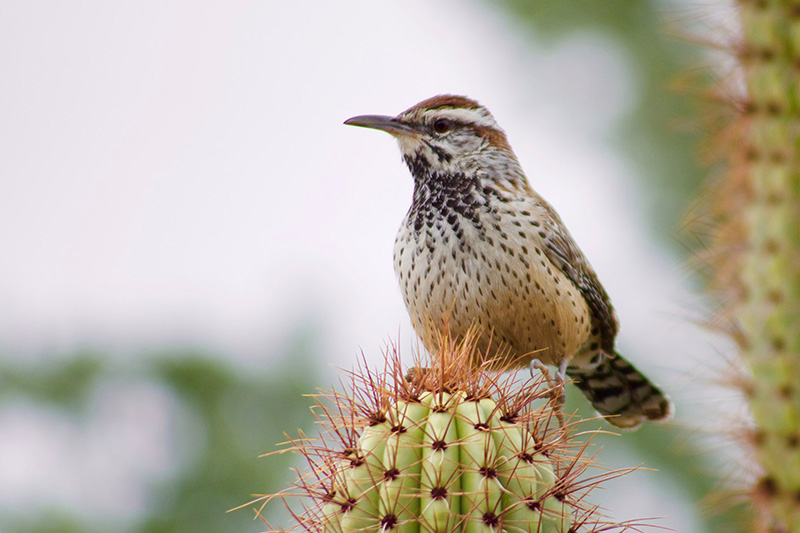1-27: I noted that the plants cactus seeds choose to settle next to are called nurse-plants, and I’m beginning to think this whole desert is my collective nurse biome. I just spent another couple hours on the ridge and the trails going to and from it. On the way up I felt a sensation that may have been attached to words or I may have added them automatically: “You will find it here.” I understood the meaning—I would find the Truth, or truths, here and, I add, wherever Nature is allowed to speak and I’m alert enough to hear. Truth is spiritual and mostly ineffable but in one of its aspects it speaks of my belonging, of the rightness of such places, of the oneness of basic reality. I usually sense all this when I hike these landscapes—it’s part of what draws me back—but I don’t often hear it spoken. I nodded and walked slowly on and a pair of Gambel quail trotted up the trail ahead of me, eventually diverting and moving into the brush and cactus. They probably start their family early in this desert so it may be only a couple months before I’d find them trailing a dozen chicks behind. Most of those won’t survive but enough will to carry on their presence here. At my home on the Pacific ocean they’re called California quail and we always have 2-3 families hanging around to take advantage of the bird seed and chicken feed Lynn hands out so liberally. They always murmur distinctively as they move through the bushes and as often as not are heard more than seen. They, a solitary raven or two, and several cactus wrens are about all I’ve seen of birds here; the wrens, too, are heard more than seen, although three came upon me exploring on a recent evening.
When I began hiking it was in East Texas forests about half my life ago. I spent at least the first year looking up reveling in the tall green of mostly pine but mixed with beech, oak, and a few other species, beginning my opening to Nature, enchanted by forest existence. In time, I happened to look around more closely, notice what had been background to forest exuberance, register some surprise—there seemed almost as many dead and fallen trees, but some still standing, as there were alive. Add the duff, inches thick cover of dead leaves and myriad other organic remains, and I saw that forest life was rooted in death. (I wasn’t aware at the time of all the fungi, microbes, insects, etc. that were hidden under the surface doing their parts along with what I saw.) Odd to acknowledge now but all this death stunned me initially. I’ve become more comfortable and knowledgeable about the balance and flow, the giving and taking, the mutualisms, and even come to believe in a sort of forest sentience and of communications passing between and among forest life. In short, I think I passed from being a visitor to sharing their home.
All of which is prelude to saying that in the richness of this piece of the Sonora Desert, I notice again how enwrapped with death and dying the lives of ecosystems are, not to mention the same experience for individual plants. One organ pipe cactus had 8 dead or dying arms each 8-9’ long but surrounding one healthy 4’ arm and another of 2’. The cactus to most appearances was a goner but still had the energy and the urge to dance a little longer with life. And such seemingly contradictory behavior is not uncommon among their brethren. Life and death, coming and going, side by side: what’s a person to think? Is this what aging looks like in an OPC (Organ Pipe Cactus)? I even saw one arm, long dead with all the flesh falling from the woody core, surrounded by other dead arms, and somehow it shot out an armlet, which surely can’t live long but even so… Clearly the world of flora handles this life and death business differently than the world of fauna. The OPC will die completely in time (I assume, though nothing would surprise me) but on the way there he sometimes pauses to be sure, tries on a little more life, moves on, may pause again, then expires. Speaking as a member of the faunal kingdom, it seems a strange, but somehow fitting, way to go. I have to consider that what I notice with my own aging may be more similar to this “trajectory-defined-by-pauses, confront the loss and adjust, get back on the trajectory toward the future,” process than I’d imagined. Death becomes almost anticlimactic, the real action happens with aging and dying.
And then there’s the packrat and/or their rodent brethren who make their homes at the base of OPCs. I’d like to know what goes on under the surface and what the OPC makes of the activity of burrowing midst its roots, but the visible construction is remarkable enough. Materials vary from twigs and branches stacked a couple feet high, often mixed with cholla segments (I try to imagine the labor of a small creature finding, dragging home, and placing those thorny objects on his stack without dying of puncture wounds) and often they’re almost exclusively cholla. It seems impenetrable by even the wiliest or hardest-skinned snake imaginable. In fact, how does the rat get in? A hole somewhere? But there goes the impenetrability. I’ll see if I can find out. But everything else aside, he creates an astonishing structure that is a monument to his determination to protect hearth and home and to immense skill in handling lethal building materials. I wonder how many residents there are; such a big structure, so much work assembling it—a family, village, city?
Beauty, natural abundance, floral diversity, ingenuity, fecundity within the given limits, communal solidarity—what a fine place.


